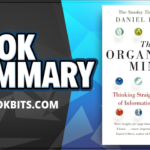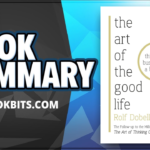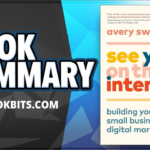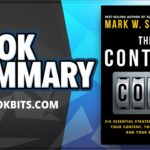GET THE 500+ BOOK SUMMARY BOX SET IN PDF & MP3 here
FOLLOW US HERE > |YouTube |Spotify | Instagram | Facebook | Newsletter | Website
The Power of Moments: Why Certain Experiences Have Extraordinary Impact by Chip Heath and Dan Heath
The New York Times bestselling authors of Switch and Made to Stick explore why certain brief experiences can jolt us and elevate us and change us–and how we can learn to create such extraordinary moments in our life and work.
While human lives are endlessly variable, our most memorable positive moments are dominated by four elements: elevation, insight, pride, and connection. If we embrace these elements, we can conjure more moments that matter. What if a teacher could design a lesson that he knew his students would remember twenty years later? What if a manager knew how to create an experience that would delight customers? What if you had a better sense of how to create memories that matter for your children?
This book delves into some fascinating mysteries of experience: Why we tend to remember the best or worst moment of an experience, as well as the last moment, and forget the rest. Why “we feel most comfortable when things are certain, but we feel most alive when they’re not.” And why our most cherished memories are clustered into a brief period during our youth.
Readers discover how brief experiences can change lives, such as the experiment in which two strangers meet in a room, and forty-five minutes later, they leave as best friends. (What happens in that time?) Or the tale of the world’s youngest female billionaire, who credits her resilience to something her father asked the family at the dinner table. (What was that simple question?)
Many of the defining moments in our lives are the result of accident or luck–but why would we leave our most meaningful, memorable moments to chance when we can create them? The Power of Moments shows us how to be the author of richer experiences.
Key Point 1: There are three types of defining moments: peaks, pits, and transitions.
There are three major things in life: peaks, pits and transitions. Peaks include the best moments of your life, such as when you get married or achieve a huge goal. Pits can be anything that’s heartbreaking to you, like losing someone close to you or failing at something important. Finally there are transitions which could be moving from one place to another or switching careers completely.
Businesses need to seek out opportunities for their customers. Some restaurants offer free desserts or other perks to people celebrating a birthday, while others give promotions or discounts when something goes wrong with a delivery. When transitions happen, they should be marked in some way depending on the circumstance. For example, real estate agents may mark the sale of a house by giving buyers a gift basket or bottle of champagne.
When someone dies, it can be a very difficult time for their family. A business may choose to help the family during this time or make things even more difficult by adding fees and other charges. In one case, a woman lost her husband before she could go on a Viking River Cruise with him. She asked if she could bring another person instead but was told that it would cost almost $1,000 in fees. Many businesses charge fees when customers want to change reservations after something has happened like losing a loved one. This is not uncommon practice among airlines and cruise lines alike because they often do not want to refund money for deceased passengers so they make it hard for families to get refunds when there are changes needed due to death of someone close.
Key Point 2: Defining moments tend to make or break the customer experience.
Defining moments are what make customers’ experiences memorable. Generally speaking, people forget most details of their daily activities. It’s the defining moments, which can either be terrible or great, that give life shape and meaning. The same principle holds true in customer service as well. Most service-related experiences are forgettable but a few will be memorable in some way whether it is positive or negative. To help ensure the defining moment is positive organizations can manipulate four building blocks: elevation (make sure your employees treat customers with respect); insight (understand how they want to be treated); pride (show them you care about them) and connection/trust (build a relationship). A defining moment can consist of one element or all four elements; however you must have at least one of each for there to truly be an experience worth remembering.”
In the era of social media, companies have to deal with negative customer experiences more than ever. For example, United Airlines faced a PR crisis after a video went viral showing police dragging off a passenger from an overbooked flight because he refused to give up his seat. Other companies have used social media to create positive experiences that are just as powerful. Morton’s Steakhouse surprised Peter Shankman when they sent someone from their restaurant to meet him at the airport with a steak and other treats in hand after he joked on Twitter about hoping for such service. This is now considered legendary online word-of-mouth advertising.
Key Point 3: Elevation can be manipulated by appealing to the senses, by raising the stakes, and by injecting an element of surprise.
Companies can use the element of elevation to create a defining moment. There are three ways to do this: appeal to your audience’s five senses, raise the stakes for them, and surprise them. Defining moments usually require at least two of these tactics.
Danny Meyer, a New York City restaurateur, has had many experiences where he elevated the dining experience of his customers. In one case, at Eleven Madison Park, a thoughtful waiter went above and beyond to make sure that a couple celebrating their anniversary had an exceptional time. The husband confessed that he’d left a bottle of champagne in his freezer at home, so the waiter brought it over as well as some chocolates and caviar. This was an incredibly thoughtful gesture that was also delicious!
Meyer elevated the dining experience at MoMA by eliminating some of the common problems with other museum eateries. He eliminated unwieldy trays and plastic packaging, and he even displayed art from the museum’s collection.
Meyer and his team have gone above and beyond for their customers. For example, Meyer instructed Tabla’s staff to track down a woman’s lost phone and wallet after she left them in a taxi while she ate lunch with her friend. By going completely outside the restaurant’s wheelhouse of food and drink, Meyer created an unforgettable moment that cost very little but earned him priceless advertising by word of mouth.
Key Point 4: One tactic for boosting pride is to break down a lofty goal into many discrete milestones.
There are four elements to a defining moment. Pride can be elevated by turning one large goal into several milestones. Fitbit devices help users reach their fitness goals in this way, since they offer rewards and badges when users hit certain milestones.
Fitbit uses a popular business strategy called gamification to motivate people. Gamification takes an everyday activity like walking and makes it more interesting by using game-like rewards. Many fitness apps use gamification to encourage users to stay healthy.
Gamification is a popular way of encouraging people to do something. For example, children can be given rewards for doing their chores. Smartphones have created new ways of gamifying things with apps that include badges and leaderboards. This was named as one of the top business trends by The New York Times in 2012, but it’s still going strong five years later. It’s proven to be more than just a trend because users are motivated by their personal pride rather than meeting goals set by others (like sales from third-party vendors)
Key Point 5: Pride can be further boosted by offering recognition and practicing courage. These tactics help create defining moments.
When people take pride in their work, they are more likely to do well. Companies have tried to leverage this idea by creating award programs for employees. However, research shows that these programs can be demotivating because of how the awards are given out and perceived injustice from those who don’t win. Employees will adapt or game the system in order to win an award rather than focusing on quality work.
People feel more appreciated when their coworkers or managers thank them for going above and beyond. It’s important to express appreciation frequently, especially in a team setting where people work together on projects. Personalized comments are often better than formal incentive programs because they show the person that you’re paying attention to what they do on the job.
Another way to build pride is by cultivating courage. Courage isn’t something you’re born with, it’s a learned skill. You can practice that skill by putting yourself in situations where you have to be courageous, like the Navy SEALs do during their training exercises. This will help your employees learn how to be brave and keep control of their emotions when they face difficult situations at work.
Key Point 6: Group insights aren’t necessarily impromptu epiphanies; they can be prompted.
Insights are powerful. They can help us build defining moments in our lives and careers. People often think of insights as epiphanies that come out of nowhere, but they’re actually prompted.
Julia Galef, the cofounder of a nonprofit organization that helps people make better decisions, uses her surprise journal to keep track of any information she finds surprising. The entries help her develop deeper insights into her own work by questioning things and identifying false assumptions.
Some companies become so insular that they develop biases and assumptions in their own favor. Microsoft was guilty of this with its tool Azure, which turned out to be unusable because of a poor user experience. However, after approaching the problem from the perspective of users during an exercise at a theater, they realized they had to redesign it.
People who approach their work with a fresh perspective can come up with better ideas. For example, the Azure team imagined what users would want instead of thinking like engineers. People can also be moved around to different departments in order to see how other people do things or even try them out for themselves. A restaurateur could offer free meals at one restaurant to staff from another restaurant so that they have an expert’s point of view on how it runs and whether or not standards are being met.
Key Point 7: Individual moments of insight often come from situations in which one stretches one’s skills and, in so doing, risks failure.
We can learn a lot from our experiences, but sometimes we have to go through challenging situations in order to understand what we’ve learned.
Many people believe that there is one career path for them, but in fact there are many. Instead of thinking about it as a true or false calling, think of your job as a prototype. The most important characteristic of a prototype is that you can refine it; no version is necessarily final. When you consider different types of work, don’t just think about them intellectually–actually try new types of work and see what happens! This will inspire more ideas than just creating theoretical models.
Key Point 8: Connection can be built through group experiences and shared struggle, or by tapping into the meaning of the work for the entire team.
A connected workforce is very effective at working together and accomplishing tasks. They are more productive, efficient, and they produce higher-quality work than those who aren’t as close to each other. Many people think that time is essential for building strong relationships with others but in certain circumstances you can build relationships quickly.
In the business world, it’s important to inspire your employees. One way to do this is through a company-wide conference where people can bond over shared struggles and goals. Another way is to simply emphasize the mission of your organization and let employees take ownership of their work.
Book Structure
Throughout this book, references to popular television shows like The Bachelor and The Simpsons sit comfortably next to academic research and case studies of successful businesses.
The authors start by introducing their ideas, and then they break the book into four sections: Elevation, Insight, Pride, and Connection. Each section has two or three chapters that cover key concepts followed by a review of what was covered in that section with real-life examples. The last part is called “clinics”, which shows how to apply those concepts in real life situations. Some of the examples are made up and some come from research conducted on business leaders.
The authors write with a unified voice. They don’t always distinguish between their own experience and information that other researchers have found. They frequently refer back to examples in the text to reinforce material or show how ideas overlap.
GET THE 500+ BOOK SUMMARY BOX SET IN PDF & MP3 here
FOLLOW US HERE > |YouTube |Spotify | Instagram | Facebook | Newsletter | Website













